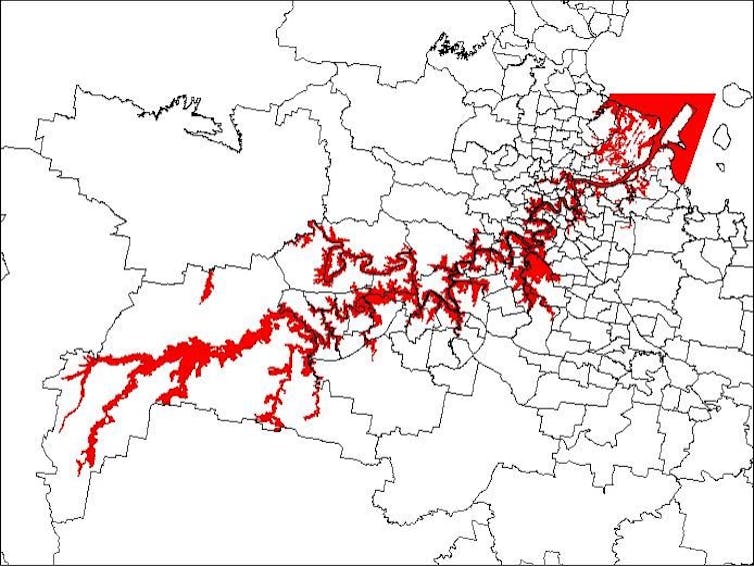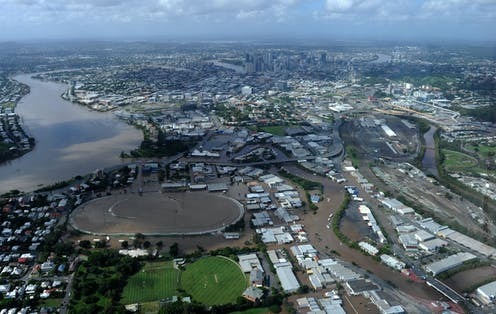Understanding the true cost of natural disasters is critical for governments to develop policies to deal with them.
Historically, calculations have been based on toting up insurance claims and government aid. But these don’t account for intangible social costs such as lower mental health and higher substance abuse in the years that follow. Nor do they account for lower economic output in affected areas.
Our latest research calculates, for the first time, the effect of a natural disaster on income tax revenue.
For this we’ve used data from the 2010-2011 floods that ravaged Brisbane and other towns in south-east Queensland. Our analysis covers about a third of Queensland’s population.
Our results show income tax revenue from the population analysed declined by 5% in the 2010/11 financial year, due to both lower incomes and higher tax-deduction claims.
Even though we can’t extrapolate this result to all disasters – type, location and size matter – our findings clearly show natural disasters have widespread financial effects, and that more frequent and severe natural disasters have clear implications for government revenue.
Queensland’s floods in context
The Queensland floods occurred between December 2010 and January 2011. As with recent floods, they were driven by the La Niña weather pattern bringing heavy and persistent rain. This was topped off by severe storms when Cyclone Yasi made landfall in northern Queensland in February 2011.
All but one of the state’s 73 local government areas were declared disaster zones. An estimated 2.5 million of the state’s 3.4 million population were affected, with 33 people killed.
The total cost calculated by Deloitte Access Economics was A$14.1 billion (in 2015 dollars). This comprised A$6.7 billion in tangible costs (such as damage to private properties and infrastructure) and A$7.4 billion in intangibles (such as impacts on health and well-being).
Brisbane River catchment area
For our research we focused on the effects on the Brisbane River catchment area in south-east Queensland. This includes Brisbane, the city of Ipswich to Brisbane’s west and smaller townships.
These were flooded in mid-January. Thousands had to evacuate and tens of thousands of homes and businesses were inundated to some degree.

2010-11 Queensland Floods Map. The Department of Natural Resources and Mines, Queensland Government
The population of this catchment area in 2010 was about 1.4 million. About 912,000 were taxpayers.
We examined data from the Australian Taxation Office’s Australian Longitudinal Individuals Files (ALife) data set, which contains an anonymous 10% random sample of all Australian tax returns filed over the past three decades. Our sample set comprised 91,208 taxpayers.
Our method, called difference-in-differences, compared the changes in economic conditions of taxpayers living in the Brisbane River catchment area with taxpayers in demographically and economically similar zones in Sydney, Melbourne, Adelaide and Perth.
Lower income, less tax
We estimate the income tax revenue from the Brisbane River catchment area was reduced by about 5% in the disaster year. This amounted to about A$400 million less tax revenue. Total income tax revenue from the area in 2009/10 was A$7.7 billion.
The decline was due both to lower incomes and higher tax deductions.
We estimate average incomes were 2.4% lower in the 2010/11 financial year.
Those on lower incomes tended to suffer the bigger percentage losses. For the bottom third of income earners – on an average A$16,200 in the 2009/10 year – average incomes were 4.2% lower in 2010/11. Those in higher-income groups lost about 1.5%.
This is consistent with previous research (using census data) showing low-income earners, part-time workers and small-business owners tend to lose the most income after disasters.
Higher deductions, less tax
Along with income losses, the value of tax deduction claims in the Brisbane river catchment area increased by about 2% in 2010/11.
These covered such things as deductions on work-related travel, clothing and “other” expenses. They also included more tax-deductible gifts and donations, which is commonly observed after a disaster.
Higher income groups claimed more deductions, reducing tax payable.
Those in the top third of incomes – earning an average of AU$91,600 – paid 3% less tax. Those in the middle third – earning an average of AU$39,000 – paid 8.7% less. There was no discernable change in income tax paid for those in the lowest income group.
Financial impacts reach far beyond direct victims
Our findings add to the growing body of research showing natural disasters have significant socio-economic effects, with income losses compounding inequality.
Our research also underlines that everyone is to some extent affected financially, as every natural disaster reduces the tax revenue collected and increases demands on the the public purse.
Quantifying the full extent of disaster costs is crucial for governments to budget and build sustainable policies investing in disaster mitigation and recovery.
With scientists predicting more frequent and severe natural disasters, we need a full picture of their likely costs, who is going to pay, and how.



 Kevin Hassett Says Inflation Is Below Target, Backs Trump’s Call for Rate Cuts
Kevin Hassett Says Inflation Is Below Target, Backs Trump’s Call for Rate Cuts  Global Demand for Yuan Loans and Bonds Surges as China Pushes Currency Internationalization
Global Demand for Yuan Loans and Bonds Surges as China Pushes Currency Internationalization  EU Delays Mercosur Free Trade Agreement Signing Amid Ukraine War Funding Talks
EU Delays Mercosur Free Trade Agreement Signing Amid Ukraine War Funding Talks  China Keeps Benchmark Lending Rates Steady as Economic Outlook Remains Cautious
China Keeps Benchmark Lending Rates Steady as Economic Outlook Remains Cautious  EU Approves €90 Billion Ukraine Aid as Frozen Russian Asset Plan Stalls
EU Approves €90 Billion Ukraine Aid as Frozen Russian Asset Plan Stalls  Silver Prices Hit Record High as Geopolitical Tensions Fuel Safe-Haven Demand
Silver Prices Hit Record High as Geopolitical Tensions Fuel Safe-Haven Demand  Wall Street Ends Higher as S&P 500, Nasdaq Extend Gains Ahead of Holiday Week
Wall Street Ends Higher as S&P 500, Nasdaq Extend Gains Ahead of Holiday Week  Global Markets Rise as Tech Stocks Lead, Yen Strengthens, and Commodities Hit Record Highs
Global Markets Rise as Tech Stocks Lead, Yen Strengthens, and Commodities Hit Record Highs  Platinum Price Surges Past $2,000 as Demand and Supply Dynamics Tighten
Platinum Price Surges Past $2,000 as Demand and Supply Dynamics Tighten  Japan Signals Possible Yen Intervention as Currency Weakens Despite BOJ Rate Hike
Japan Signals Possible Yen Intervention as Currency Weakens Despite BOJ Rate Hike  Yen Slides as BOJ Caution Undercuts Rate Hike Impact
Yen Slides as BOJ Caution Undercuts Rate Hike Impact  Oil Prices Climb in Asian Trade as Venezuela Sanctions and Middle East Tensions Fuel Risk Premium
Oil Prices Climb in Asian Trade as Venezuela Sanctions and Middle East Tensions Fuel Risk Premium  UK Economy Grows 0.1% in Q3 2025 as Outlook Remains Fragile
UK Economy Grows 0.1% in Q3 2025 as Outlook Remains Fragile  Trump Defends Economic Record in North Carolina as Midterm Election Pressure Mounts
Trump Defends Economic Record in North Carolina as Midterm Election Pressure Mounts  Oil Prices Ease in Asia as Geopolitical Risks Clash With Weak Demand Outlook
Oil Prices Ease in Asia as Geopolitical Risks Clash With Weak Demand Outlook  South Korea Central Bank Warns of Rising Financial Stability Risks Amid Won Volatility
South Korea Central Bank Warns of Rising Financial Stability Risks Amid Won Volatility  Gold Prices Surge to Record Highs as Geopolitical Tensions Fuel Safe-Haven Demand
Gold Prices Surge to Record Highs as Geopolitical Tensions Fuel Safe-Haven Demand 





























